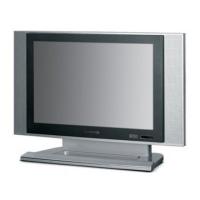How to fix Daewoo DLP-17D3 LCD TV control/system lock up?
- BBrad HernandezSep 7, 2025
To resolve a control/system lock up on your Daewoo LCD TV, switch your TV off and on again with the main button on the TV set.

How to fix Daewoo DLP-17D3 LCD TV control/system lock up?
To resolve a control/system lock up on your Daewoo LCD TV, switch your TV off and on again with the main button on the TV set.
What to do if Daewoo Plasma TV has no picture in TV mode?
If your Daewoo Plasma TV shows no picture in TV mode, ensure the AC connection is secure and the power switch is turned on. You should also inspect the adapter, inverter, and panel. Additionally, check components I403, I405, I501 and the tuner.
What to do if Daewoo Plasma TV has no picture in External input mode?
If your Daewoo Plasma TV displays no picture when using an external input, first, make sure the AC connection is properly connected and that the power switch is in the ON position. Next, check the adapter, inverter, and panel. Finally, inspect the main PCB and sub-JACK PCB.
What to do if Daewoo Plasma TV has no sound in External input mode?
If there is no sound on your Daewoo Plasma TV when using an external input, check the speaker connections first. If the connections are fine, try exchanging the speaker or the speaker cable. Also, check the 1st and 3rd pin of P12 output while inputting a 1KHz Sine Signal.
What to do if Daewoo Plasma TV shows a white screen?
If your Daewoo Plasma TV screen is white, check the panel connection. Also, check the Main PCB and the connector or Main PCB.
How to fix Daewoo Plasma TV key if it does not operate?
If the key on your Daewoo Plasma TV is not working, check the key cable and I501. If the problem persists, replace the Key PCB.
| Screen Size | 17 inches |
|---|---|
| Display Technology | LCD |
| Aspect Ratio | 5:4 |
| Contrast Ratio | 500:1 |
| Brightness | 250 cd/m² |
| Resolution | 1280 x 1024 pixels |
| Inputs | VGA, Composite, S-Video |
| Weight | 4.5 kg |
Covers risks of electric shock, operation warnings, and protection from moisture.
Provides instructions for recycling used electrical and electronic equipment.
Guidance on cleaning, placement, heat, water, attachments, and power sources.
Covers wall mounting, pixel behavior, fixed images, and moving the TV safely.
Ensuring proper ventilation and avoiding heat, moisture, dust, and vibration.
Advice on object entry, lightning, cleaning, and internal service.
Details on buttons for TV and Teletext modes, including their functions and labels.
Explains the function of buttons and indicators on the TV's front panel.
Identifies and describes all input/output terminals on the rear of the TV.
Step-by-step guide for inserting batteries into the remote control handset.
Instructions for connecting the AC adapter and power cord to the TV and outlet.
Guidance on connecting an aerial cable directly to the TV's aerial terminal.
Instructions for linking the TV's aerial input through a VCR.
Diagrams and descriptions for connecting set-top boxes, DVD players, and camcorders.
How to switch between different input sources and use various connection jacks.
Guide for selecting the preferred language for on-screen menus.
Instructions for using the ATSS function to scan and store TV channels.
Procedures for switching the TV on, off, and to standby mode using various controls.
Methods for selecting programs and adjusting TV/headphone volume.
Using sound mute, mono forcing, and dual language options.
Adjusting spatial sound, balance, equalizer, and AVL for optimal audio.
Selecting picture presets and adjusting brightness, contrast, sharpness, and tint.
Setting the TV to automatically switch to standby after a specified time.
Controlling aspect ratio for different screen formats like ZOOM and FULL SCREEN.
Configuring Child Lock, Wake Up, and Clock settings.
How to display and exit the main menu structure.
Guide on navigating and adjusting settings within sub-menus like Picture, Sound, Install, Features.
Detailed settings for backlight, brightness, contrast, colour, sharpness, and noise reduction.
Adjustments for volume, balance, equalizer presets, and automatic volume leveling (AVL).
Customizing sound equalizer bands and managing channel installation.
Procedures for removing unwanted channels or skipping them during channel surfing.
How to change channel order and perform manual frequency tuning.
Steps for searching channels by frequency and performing fine-tuning.
Entering station names and changing the TV system (e.g., PAL, NTSC).
Managing Child Lock, Wake Up, Clock, Zoom Auto, Language, and PC Input settings.
Guide to choosing the preferred language for the TV's interface.
Table showing supported PC resolutions and frequencies for optimal display.
Steps to enter teletext mode, switch pages, and use TAT/PAT functions.
Methods for selecting teletext pages via number entry, page up/down, and color links.
Using Index, Subpage, Page Hold, and Reveal functions for enhanced teletext use.
Adjusting character height, volume, brightness, and transparency in teletext mode.
How to watch programs with teletext subtitles and maintain picture format.
General instructions for attaching VESA mounting devices to the TV.
Specific steps for securing VESA mounting interface pads and brackets.
Guidance for resolving issues like system lock-up, remote control, no picture/sound.
Troubleshooting tips for poor picture sharpness, ghosting, and interference.